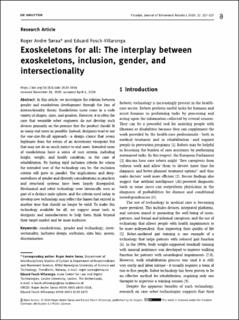| dc.contributor.author | Søraa, Roger Andre | |
| dc.contributor.author | Fosch-Villaronga, Eduard | |
| dc.date.accessioned | 2020-06-08T08:34:23Z | |
| dc.date.available | 2020-06-08T08:34:23Z | |
| dc.date.created | 2020-06-05T12:51:44Z | |
| dc.date.issued | 2020 | |
| dc.identifier.citation | Paladyn - Journal of Behavioral Robotics. 2020, 11 (1) | en_US |
| dc.identifier.issn | 2080-9778 | |
| dc.identifier.uri | https://hdl.handle.net/11250/2657132 | |
| dc.description.abstract | In this article, we investigate the relation between gender and exoskeleton development through the lens of intersectionality theory. Exoskeleton users come in a wide variety of shapes, sizes, and genders. However, it is often the case that wearable robot engineers do not develop such devices primarily on the premise that the product should fit as many end users as possible. Instead, designers tend to use the one-size-fits-all approach – a design choice that seems legitimate from the return of an investment viewpoint but that may not do as much justice to end users. Intended users of exoskeletons have a series of user criteria, including height, weight, and health condition, in the case of rehabilitation. By having rigid inclusion criteria for whom the intended user of the technology can be, the exclusion criteria will grow in parallel. The implications and deep-rootedness of gender and diversity considerations in practices and structural systems have been largely disregarded. Mechanical and robot technology were historically seen as part of a distinct male sphere, and the criteria used today to develop new technology may reflect the biases that existed in another time that should no longer be valid. To make this technology available for all, we suggest some tools to designers and manufacturers to help them think beyond their target market and be more inclusive. | en_US |
| dc.language.iso | eng | en_US |
| dc.publisher | DeGruyter | en_US |
| dc.rights | Navngivelse 4.0 Internasjonal | * |
| dc.rights.uri | http://creativecommons.org/licenses/by/4.0/deed.no | * |
| dc.title | Exoskeletons for all: The interplay between exoskeletons, inclusion, gender and intersectionality | en_US |
| dc.type | Peer reviewed | en_US |
| dc.type | Journal article | en_US |
| dc.description.version | publishedVersion | en_US |
| dc.source.volume | 11 | en_US |
| dc.source.journal | Paladyn - Journal of Behavioral Robotics | en_US |
| dc.source.issue | 1 | en_US |
| dc.identifier.doi | https://doi.org/10.1515/pjbr-2020-0036 | |
| dc.identifier.cristin | 1814025 | |
| dc.description.localcode | Open Access CC-BY | en_US |
| cristin.ispublished | true | |
| cristin.fulltext | postprint | |
| cristin.fulltext | original | |
| cristin.qualitycode | 1 | |

